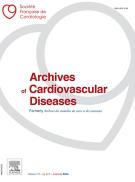Early and late bleeding events according to Valve Academic Research Consortium 3 criteria following transcatheter aortic valve implantation - 04/04/25

Graphical abstract |
Highlights |
• | Retrospective analysis of 487 TAVI recipients treated at one high-volume centre. |
• | Classification of bleeding events according to the VARC-2 and VARC-3 criteria. |
• | Early bleeding occurred in 12.5% of patients, mainly at the primary access site. |
• | Late bleeding occurred in 6.1% of patients. |
• | Late bleeding was associated with treatment by VKA at discharge. |
• | Early bleeding was not associated with late all-cause mortality. |
• | No significant difference according to bleeding classifications. |
Abstract |
Background |
Transcatheter aortic valve implantation may be associated with significant haemorrhagic complications.
Aims |
To evaluate the timing, incidence, predictors and clinical impact of bleeding events after transcatheter aortic valve implantation, according to the updated Valve Academic Research Consortium (VARC)-3 criteria, compared with the VARC-2 criteria.
Methods |
A retrospective observational study involving 487 consecutive patients who underwent transcatheter aortic valve implantation between July 2017 and May 2019 was performed. Bleeding events were classified according to the VARC-2 and VARC-3 definitions.
Results |
Bleeding events occurred in 17.6% of patients, with early bleeding (in-hospital) in 12.5% and late bleeding (occurring after discharge) in 6.1%. The primary vascular access site was the most common source of early bleeding, whereas gastrointestinal bleeding was predominant in late events. Significant predictors of early VARC-3-defined bleeding included active cancer, previous implantable cardioverter-defibrillator, history of mitral valve surgery, a non-transfemoral approach and occurrence of an in-hospital major vascular complication or new-onset atrial fibrillation. Late bleeding was independently associated with a history of myocardial infarction and treatment with vitamin K antagonists at discharge. Early bleeding events were not associated with increased late all-cause mortality. No significant difference was observed based on the VARC-2 and VARC-3 bleeding definitions.
Conclusions |
Bleeding events occurred in one sixth of patients undergoing transcatheter aortic valve implantation without significant difference in their incidence between the VARC-2 and VARC-3 classifications. Early bleeding events were not associated with poorer long-term survival, regardless of the classification used. Larger studies with greater statistical power, including more contemporary patients, are needed to confirm these findings.
Le texte complet de cet article est disponible en PDF.Keywords : Transcatheter aortic valve implantation, Bleeding, VARC-3, VARC-2, Mortality
Plan
| ☆ | X post (Tweet): What are the incidence, timing, predictors and impact of VARC-3-defined bleeding events following transcatheter aortic valve implantation?. |
Vol 118 - N° 4
P. 248-259 - avril 2025 Retour au numéroBienvenue sur EM-consulte, la référence des professionnels de santé.
L’accès au texte intégral de cet article nécessite un abonnement.
Déjà abonné à cette revue ?

